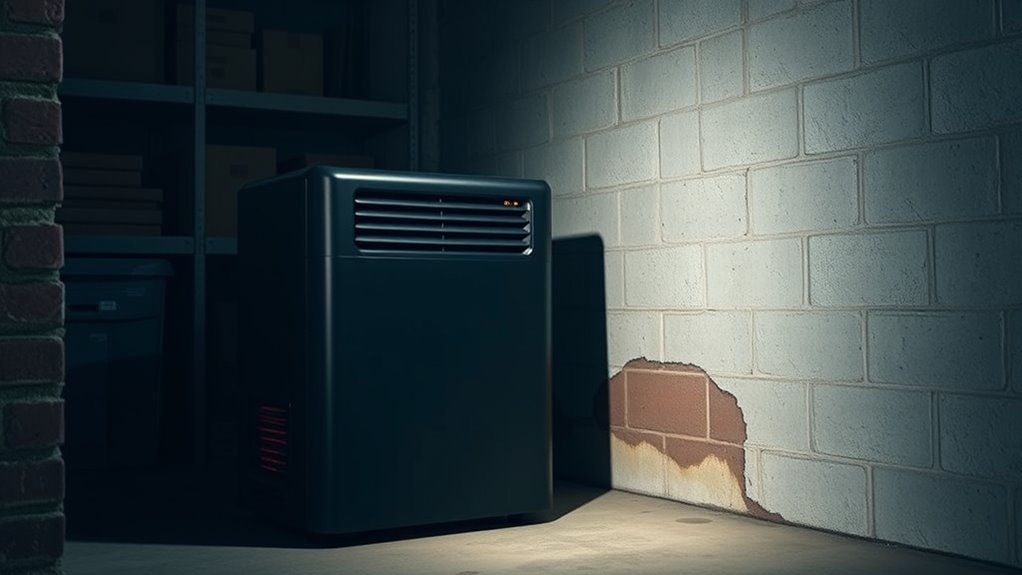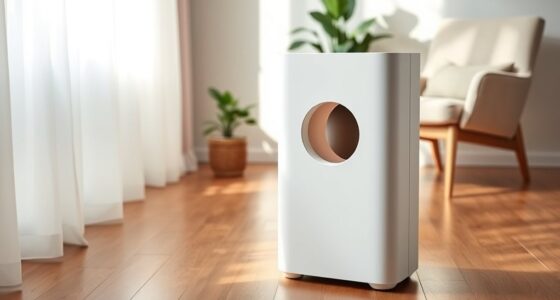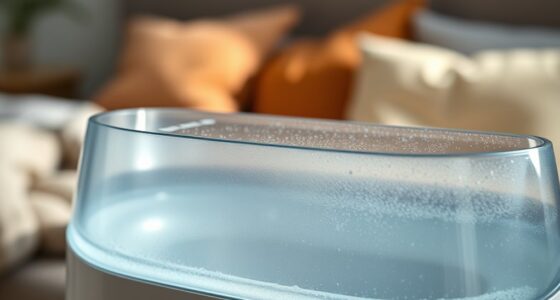To maximize basement dryness without wasting power, place your dehumidifier near damp walls or problem areas, ensuring it’s slightly elevated to enhance airflow. Keep at least 12 inches clear of furniture and obstacles, and avoid blocking vents to improve efficiency. Regularly monitor humidity levels and adjust its position if needed. Proper placement means better moisture control and energy savings—continue exploring these tips to optimize your setup even further.
Key Takeaways
- Position the dehumidifier near damp walls or moisture hotspots to target high humidity areas effectively.
- Keep at least 12 inches of clearance from furniture, walls, and obstructions to ensure proper airflow and efficiency.
- Elevate the unit on a sturdy platform and maintain several inches of space around it to prevent overheating and facilitate maintenance.
- Avoid blocking vents and ensure unobstructed airflow for consistent operation and even moisture removal.
- Regularly monitor humidity levels and adjust placement as needed to optimize moisture extraction and minimize power consumption.
Choosing the Optimal Location in Your Basement
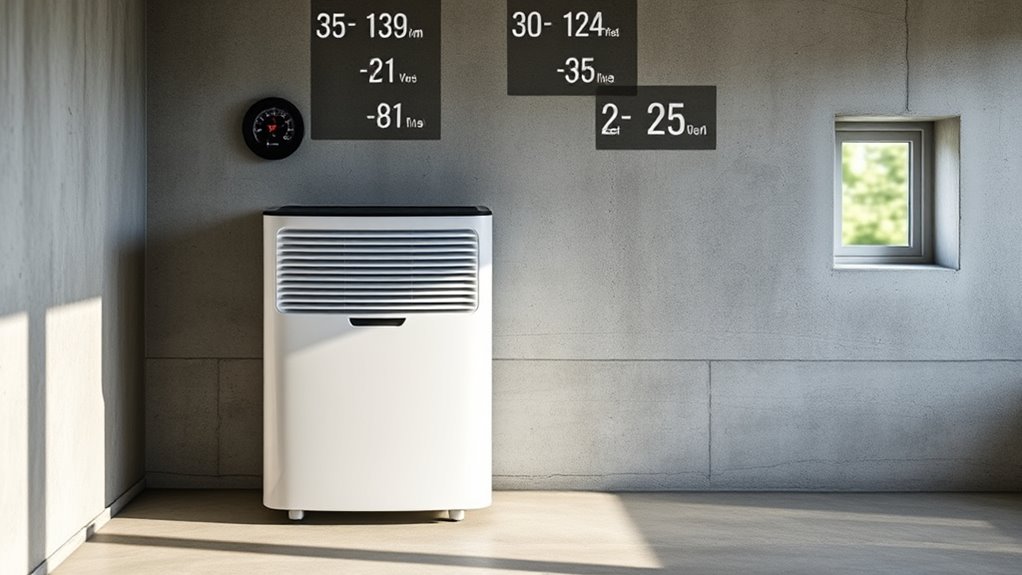
Finding the best spot for your dehumidifier in the basement can make a big difference in its effectiveness. You want to place it where humidity levels tend to be highest, such as near damp walls or corners. Positioning your dehumidifier in these areas ensures it can efficiently extract excess moisture, maintaining ideal humidity levels. This strategic placement also aligns with industry recommendations for optimal dehumidifier positioning, ensuring the device works more effectively. This not only keeps your basement dry but also helps you save energy by avoiding unnecessary run time. When the dehumidifier is in the right location, it works more efficiently, reducing power consumption and lowering your energy bills. Remember, the goal is to target the most humid zones without obstructing airflow, so choose a spot that balances accessibility with functionality. Proper placement is key to a comfortable, dry basement.
Avoiding Obstructions and Ensuring Proper Airflow
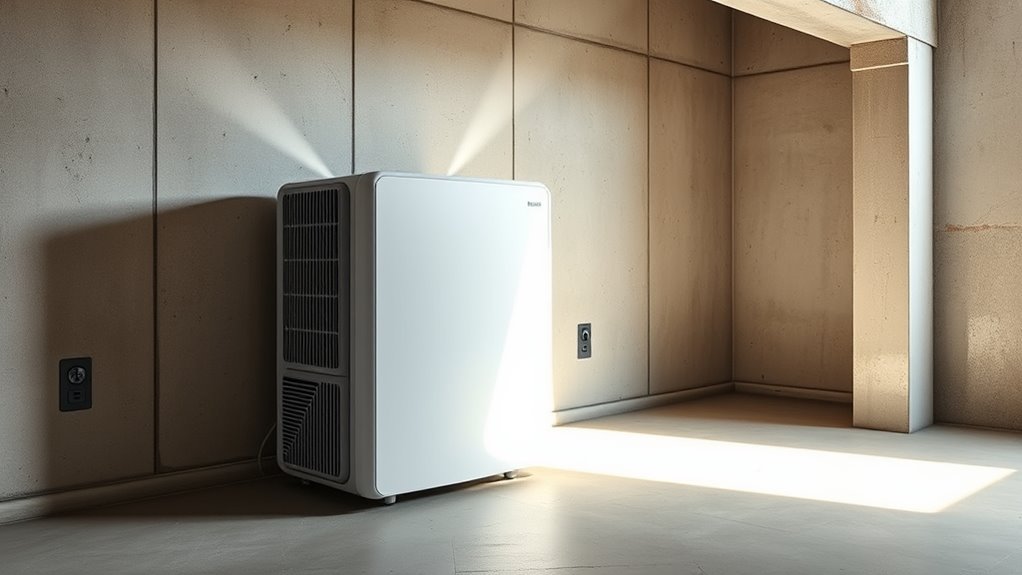
To keep your dehumidifier running efficiently, it’s vital to avoid placing it near obstructions like furniture, boxes, or curtains that can block airflow. Airflow obstruction reduces the dehumidifier’s ability to pull moisture from the air, decreasing its effectiveness and wasting power. To maximize power efficiency, guarantee there’s enough space around the unit for air to circulate freely. Use the table below to identify common obstructions and recommended clearances:
| Obstruction | Recommended Clearance |
|---|---|
| Furniture or boxes | At least 12 inches away |
| Curtains or drapes | Keep at least 6 inches free |
| Wall surfaces | Maintain 12 inches distance |
| Cluttered corners | Clear for optimal airflow |
Proper airflow keeps your dehumidifier running smoothly and ensures basement dryness without wasting power. Additionally, understanding the importance of AI-powered devices can help you select the most efficient models for your needs.
Positioning Near Moisture Sources and Problem Areas
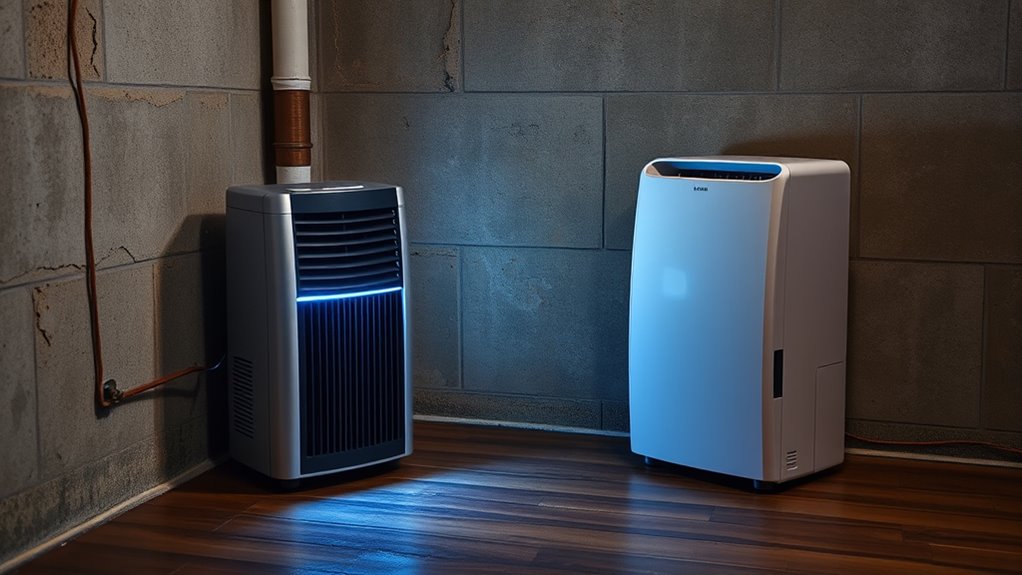
Are you placing your dehumidifier in the best spot to tackle persistent moisture problems? Positioning it near known moisture sources, like leaks or damp walls, helps target high humidity levels directly. Placing the unit close to problem areas ensures it works efficiently, reducing excess moisture quickly. Good air circulation is essential; avoid blocking vents or placing the dehumidifier in corners where air gets trapped. Instead, choose a central location near moisture hotspots to promote even airflow throughout the basement. This strategic placement allows the dehumidifier to effectively lower humidity levels, preventing mold growth and musty odors. Regularly monitor humidity levels to confirm your placement is working, and adjust if needed. Proper positioning near moisture sources maximizes efficiency and keeps your basement dry without wasting power. Optimal placement is key to achieving a comfortable, healthy environment.
Elevating and Maintaining Clear Space Around the Dehumidifier
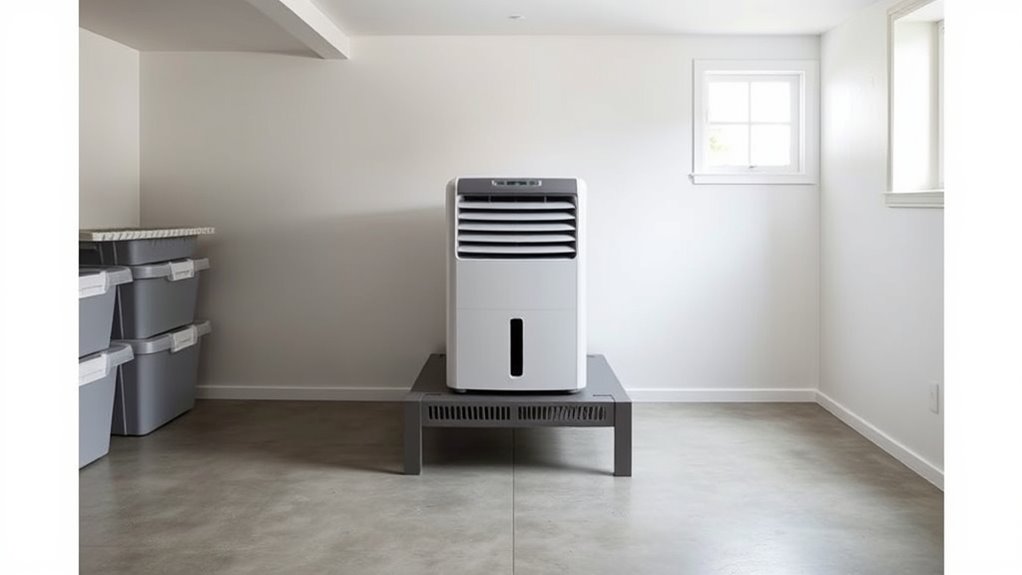
Elevating your dehumidifier and keeping space around it clear enhances its performance and longevity. Proper placement allows airflow to circulate freely, making humidifier maintenance easier and more effective. Guarantee there’s at least a few inches of clearance on all sides to prevent overheating and optimize moisture removal. Elevate the unit on a sturdy platform if necessary, especially on uneven floors. This helps avoid dust buildup and reduces the risk of damage. Following these energy saving tips, such as avoiding obstructed vents, minimizes unnecessary power consumption. Regularly check that the area remains uncluttered and free of obstructions to keep your dehumidifier working efficiently. Proper elevation and clear space not only improve performance but also extend the device’s lifespan. Ensuring correct dehumidifier placement supports optimal operation and energy efficiency.
Monitoring and Adjusting Placement for Maximum Efficiency
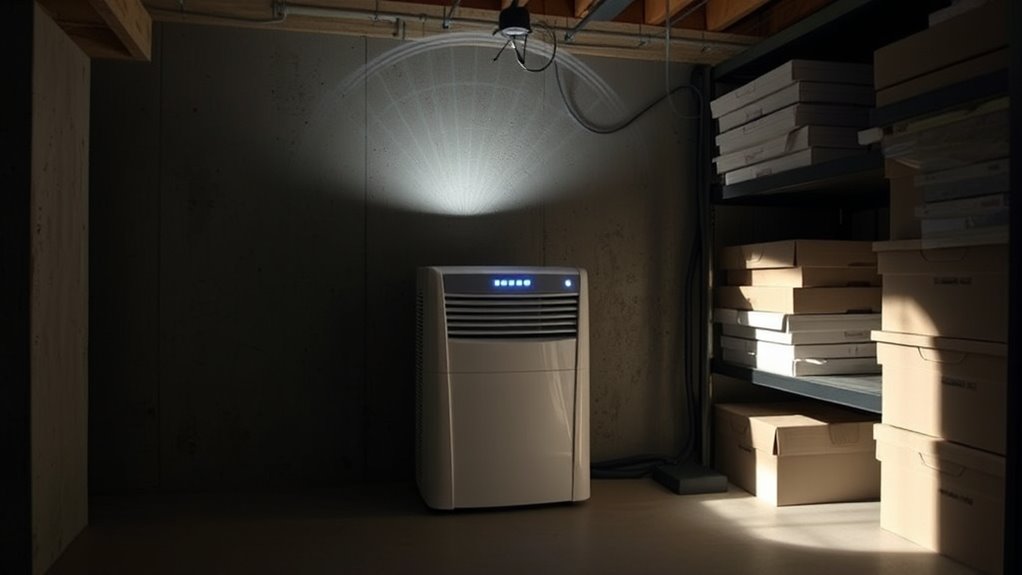
Regularly monitoring your dehumidifier’s placement guarantees it operates at peak efficiency. Use humidity sensors to track moisture levels in different basement areas, helping you identify if the unit is effectively reducing humidity. If readings stay high or fluctuate, consider repositioning the dehumidifier to a more strategic spot, such as closer to moisture sources or in central locations. Adjusting placement can substantially lower power consumption by preventing the unit from working harder than necessary. Keep an eye on the dehumidifier’s performance and noise levels, which can also signal if it’s ideally placed. Regular checks ensure you’re maximizing moisture removal while minimizing energy use, saving you money and protecting your basement from excess dampness. Fine-tuning placement based on humidity data keeps your basement dry efficiently. Incorporating smart home devices can further optimize dehumidifier operation and energy savings.
Frequently Asked Questions
How Often Should I Reposition My Dehumidifier for Optimal Results?
You should reposition your dehumidifier every 1 to 2 months to maintain airflow optimization and guarantee effective moisture removal. Regular dehumidifier maintenance, like cleaning filters and checking vents, helps it operate efficiently. Moving it periodically prevents stagnation and ensures even coverage across your basement. Pay attention to moisture levels and airflow, adjusting placement as needed, especially if you notice damp spots or reduced performance.
Can Placing It Near Windows Improve Moisture Control?
Think of your dehumidifier as a lighthouse guiding moisture away. Placing it near windows can help, but focus on airflow optimization. Position it where air circulates freely, not blocked by curtains or furniture. While windows might seem logical, make certain the dehumidifier isn’t directly exposed to outside humidity or drafts. Proper placement near windows can assist moisture control, but prioritize airflow for the best results.
What Are Signs My Dehumidifier Is Incorrectly Placed?
You’ll notice your dehumidifier is incorrectly placed if it makes excessive humidifier noise or seems to use more power than usual. If it’s too close to walls or furniture, airflow gets restricted, increasing power consumption and noise. Also, if it’s near windows or leaks, it won’t effectively reduce humidity. Proper placement guarantees efficient moisture control, minimizes noise, and keeps power use in check.
Is It Better to Place It Higher or Lower in the Basement?
You should place your dehumidifier lower in the basement to improve air circulation and prevent moisture accumulation. A lower position allows it to draw in more humid air rising from the floor, promoting even drying. Make sure there’s enough space around it for proper airflow, and avoid placing it near walls or clutter. This setup maximizes efficiency, reduces excess moisture, and keeps your basement dry without wasting power.
How Does Ambient Temperature Affect Placement Effectiveness?
Temperature influence considerably impacts your placement strategies. Cooler areas tend to hold more moisture, so placing your dehumidifier where the ambient temperature is moderate ensures ideal performance. Avoid spots near heat sources or direct sunlight, as higher temperatures can reduce efficiency. Conversely, extremely cold zones might cause the dehumidifier to work harder, wasting power. Position it in a spot with stable, moderate temperature to maximize moisture removal without unnecessary energy use.
Conclusion
By carefully placing your dehumidifier, you’ll keep your basement dry and save energy. Remember to avoid obstructions, position it near moisture sources, and maintain clear space around it. Regularly monitor and adjust its placement for peak performance. Isn’t it worth the effort to create a healthier, more comfortable space without wasting power? With these tips, you’ll enjoy a drier basement and better efficiency—making your home more livable and your energy bills lower.
